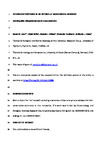Evidence of fostering in an internally brooding sea anemone
| dc.contributor.author | Lane, Sarah | |
| dc.contributor.author | Briffa, Mark | |
| dc.contributor.author | Wilson, AJ | |
| dc.contributor.author | Truebano, M | |
| dc.contributor.author | Foster, Nicola | |
| dc.date.accessioned | 2020-11-10T16:13:38Z | |
| dc.date.issued | 2020-12 | |
| dc.identifier.issn | 0179-1613 | |
| dc.identifier.issn | 1439-0310 | |
| dc.identifier.other | eth.13088 | |
| dc.identifier.uri | http://hdl.handle.net/10026.1/16646 | |
| dc.description.abstract |
<jats:title>Abstract</jats:title><jats:p>Evidence of alloparental care during the incubation stage has largely been demonstrated for species that incubate their offspring externally in a nest. Alloparental care in these species generally consists of the rearing of mixed broods which contain a low proportion of “foreign” young alongside the host's own offspring. However, many animals, including sea anemones, incubate offspring either on or within their bodies. The beadlet anemone <jats:italic>Actinia equina</jats:italic> incubate their young internally, and as many sea anemones are capable of reproducing both sexually and asexually, the origin of these internally brooded young has been the subject of much debate. While genetically identical young are brooded internally under the juvenile stage, it is thought that those produced sexually are released as larvae into the water and must return to the gastric cavity of an adult in order for metamorphosis to occur. As the likelihood of a planula larva finding its way back to its parent is slim, this suggests that alloparental care may play a role in the survival of juveniles in this species, a hypothesis first suggested a century ago but rarely tested. Here, using highly polymorphic microsatellite markers, we find evidence of alloparental care in <jats:italic>A. equina</jats:italic>. Our results indicate that while a high proportion of juveniles were genetically identical to their brooding adult, the remaining juveniles showed stark genetic differences to their brooding adult. These juveniles shared far fewer alleles with their “parent” than expected under sexual reproduction, indicating that they were not the adult's offspring. Furthermore, we found variation in the genetic composition of broods, which consisted either of (a) entirely genetically identical individuals, (b) a mix of unique individuals and clonemates or (c) entirely unique individuals, that is no shared genotype. Our results thus indicate that adult <jats:italic>A. equina</jats:italic> tolerate the presence of non‐offspring within their gastric cavity and furthermore that they may incubate entirely “foreign” broods.</jats:p> | |
| dc.format.extent | 1141-1147 | |
| dc.language | en | |
| dc.language.iso | en | |
| dc.publisher | Wiley | |
| dc.subject | alloparental care | |
| dc.subject | asexual reproduction | |
| dc.subject | brooding | |
| dc.subject | sea anemones | |
| dc.title | Evidence of fostering in an internally brooding sea anemone | |
| dc.type | journal-article | |
| dc.type | Journal Article | |
| plymouth.author-url | https://www.webofscience.com/api/gateway?GWVersion=2&SrcApp=PARTNER_APP&SrcAuth=LinksAMR&KeyUT=WOS:000569259200001&DestLinkType=FullRecord&DestApp=ALL_WOS&UsrCustomerID=11bb513d99f797142bcfeffcc58ea008 | |
| plymouth.issue | 12 | |
| plymouth.volume | 126 | |
| plymouth.publication-status | Published | |
| plymouth.journal | Ethology | |
| dc.identifier.doi | 10.1111/eth.13088 | |
| plymouth.organisational-group | /Plymouth | |
| plymouth.organisational-group | /Plymouth/Faculty of Health | |
| plymouth.organisational-group | /Plymouth/Faculty of Health/School of Psychology | |
| plymouth.organisational-group | /Plymouth/Faculty of Science and Engineering | |
| plymouth.organisational-group | /Plymouth/Faculty of Science and Engineering/School of Biological and Marine Sciences | |
| plymouth.organisational-group | /Plymouth/REF 2021 Researchers by UoA | |
| plymouth.organisational-group | /Plymouth/REF 2021 Researchers by UoA/UoA04 Psychology, Psychiatry and Neuroscience | |
| plymouth.organisational-group | /Plymouth/REF 2021 Researchers by UoA/UoA07 Earth Systems and Environmental Sciences | |
| plymouth.organisational-group | /Plymouth/Research Groups | |
| plymouth.organisational-group | /Plymouth/Research Groups/Marine Institute | |
| plymouth.organisational-group | /Plymouth/Users by role | |
| plymouth.organisational-group | /Plymouth/Users by role/Academics | |
| plymouth.organisational-group | /Plymouth/Users by role/Researchers in ResearchFish submission | |
| dcterms.dateAccepted | 2020-08-17 | |
| dc.rights.embargodate | 2020-11-12 | |
| dc.identifier.eissn | 1439-0310 | |
| dc.rights.embargoperiod | Not known | |
| rioxxterms.versionofrecord | 10.1111/eth.13088 | |
| rioxxterms.licenseref.uri | http://www.rioxx.net/licenses/all-rights-reserved | |
| rioxxterms.licenseref.startdate | 2020-12 | |
| rioxxterms.type | Journal Article/Review | |
| plymouth.funder | The role of additive and non-additive genetic effects during animal contests in the beadlet sea anemone Actinia equina::BBSRC |


